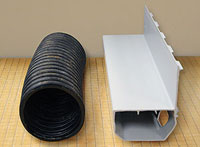Drainage SystemSo if an exterior drainage system is not the answer, what is? An interior water drainage system! By installing a drainage system around the inside of the basement along the wall, you can capture water at the most common point of entry - the floor/wall joint. You can also capture water from the walls and prevent the center of the basement floor from leaking by intercepting the water at the perimeter of the floor before it gets to the center.
Even in basements that are already finished, it's still much easier to waterproof from the inside than the outside. Most full-time basement waterproofing companies offer interior drainage systems - between which there are big differences in systems. Some are old-fashioned and generic, and others are modern and specially designed for the job.
Clay or plastic, the pipe was usually laid alongside the footing In some cases, such as in basements where there is no footing (i.e.; monolithic basement floors), a system called DryTrak®, which is a baseboard water drainage system, may be installed. All Basement Systems dealers install the most appropriate drainage system for your basement. Contact your local waterproofing contractor today by calling 1-800-638-7048 or online for a free estimate and inspection. |
Looking for a price? Get a no cost, no obligation free estimate.
 In the 1950's and before, clay pipe sections about 18 inches long were used for underground and under-floor drains. There were no holes in the pipe, but instead the sections were laid with a quarter-inch space between them to let in water. Since the pipe sections were made from clay tile material - like a chimney flue pipe or a brick- they called it drain "tile." This term,
In the 1950's and before, clay pipe sections about 18 inches long were used for underground and under-floor drains. There were no holes in the pipe, but instead the sections were laid with a quarter-inch space between them to let in water. Since the pipe sections were made from clay tile material - like a chimney flue pipe or a brick- they called it drain "tile." This term,  in
in